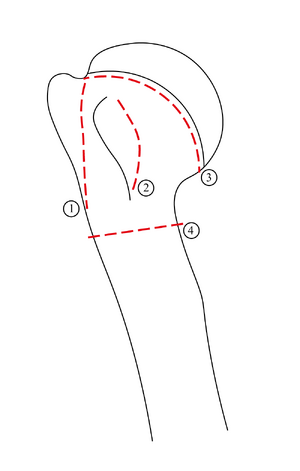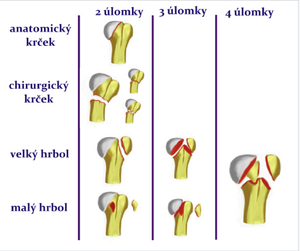Humeral head fractures
From WikiLectures
Fracture of the head of the humerus occurs most often in older patients (in young people, the shoulder joint is more likely to luxate , in children it is more likely to be epiphyseolysis of the head).
AO classification[edit | edit source]
A – extra-articular two-fragmented
B – extra-articular three-fragmented
C – intra-articular
Classification according to Neer[edit | edit source]
- According to number of fragments
They correspond to 4 anatomical zones
- Head
- Greater tubercle
- Lesser tubercle
- Diaphysis
- According to number of fragments
They correspond to 4 anatomical source
- head
- Greater tubercle
- Lesser tubercle
- diaphysis
- According to their dislocation
i.e. displacement over 1 cm or deflection over 45°
- I – No dislocation (any number of fragments)
- II – two-fragment with dislocation
- III – three-fragment with dislocation
- IV – four-fragment with dislocation
Classification according to Zeman[edit | edit source]
- anatomical neck fracture
- surgical neck fracture
- fracture of the greater tubercle
- fracture of the lesser tubercle
- anterior luxation fractures
- posterior luxation fractures
- According to the dislocation
- According to the dislocation of the fragment
- Discloated fragments
- Rupture of the greater tubercle – supraspinatus tendon tear (rotator cuff)
- Rupture of the lesser tubercle – subscapularis tendon tear medially
- Fracture of the surgical neck – pull of the distal fragment medially ( pectoralis major)
If both cusps are broken off with a neck fracture, the head is at risk of avascular necrosis (in general, the head is at risk in intra-articular fractures, which have a worse prognosis than extra-articular)
Clinical picture and diagnosis[edit | edit source]
- changes in configuration of the shoulder, edema , antalgic posture, limited movement, crepitation of fragments, runaway hematomas, in case of luxation fractures, an empty socket of the shoulder joint
- Diagnostics
- it is necessary to examine the innervation (injury of the axillaris nerve during neck fractures) and the pulse on the radial artery
- x-ray in two projections
Therapy[edit | edit source]
Conservative (mainly in type A)[edit | edit source]
- not dislocated, dislocated stable after reduction
- immobilization in abduction for 3-4 weeks (Desault bandage with axilla padding, abduction splint - 30° forearm flexion and 60° abduction, hanging plaster, scarf sling)
- early rehabilitation
Surgery (type B and C)[edit | edit source]
- closed irreplaceable or redeployable nonretinable, open and luxation fractures, fractures complicated by injury to blood vessels and nerves:
- closed reduction and MIO (e.g. intramedullary osteosynthesis according to Hacketal)
- open reduction and plate osteosynthesis (T-plate, PHILOS – proximal humeral internal locking system)
- secured nail (PHN – proximal humeral nail)
- screws, K-wires, traction cerclage in multifragmentary fractures
- CKP in comminuted fractures with risk of avascular necrosis of the head
Specific treatment solutions[edit | edit source]
- tuberosity fractures - non-dislocated: rest in a sling for 7 days, dislocated: screws or traction cerclage
- neck fractures - non-dislocated immobilization in Desault for 3-4 weeks (in the young, where there is no such risk of shoulder stiffness), hanging cast for 4-6 weeks in the elderly (allows early swinging movements in the shoulder), plate osteosynthesis (PHILOS) during surgical treatment or PHN
- multifragment head fractures – surgical treatment with osteosynthesis (screws, K-wires), possibly CCP



